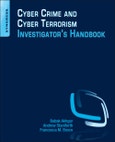Cyber Crime and Cyber Terrorism Investigator's Handbook is a vital tool in the arsenal of today's computer programmers, students, and investigators. As computer networks become ubiquitous throughout the world, cyber crime, cyber terrorism, and cyber war have become some of the most concerning topics in today's security landscape. News stories about Stuxnet and PRISM have brought these activities into the public eye, and serve to show just how effective, controversial, and worrying these tactics can become.
Cyber Crime and Cyber Terrorism Investigator's Handbook describes and analyzes many of the motivations, tools, and tactics behind cyber attacks and the defenses against them. With this book, you will learn about the technological and logistic framework of cyber crime, as well as the social and legal backgrounds of its prosecution and investigation. Whether you are a law enforcement professional, an IT specialist, a researcher, or a student, you will find valuable insight into the world of cyber crime and cyber warfare.
Edited by experts in computer security, cyber investigations, and counter-terrorism, and with contributions from computer researchers, legal experts, and law enforcement professionals, Cyber Crime and Cyber Terrorism Investigator's Handbook will serve as your best reference to the modern world of cyber crime.
Please Note: This is an On Demand product, delivery may take up to 11 working days after payment has been received.
Table of Contents
1. Cyberspace: The new frontier for policing? 2. Definitions of Cyber Terrorism 3. New and emerging threats of cyber crime and terrorism 4. Police investigation processes: practical tools and techniques for tackling cyber crimes 5. Cyber-specifications: capturing user requirements for cyber-security investigations 6. High-tech investigations of cyber crime 7. Seizing, imaging, and analyzing digital evidence: step-by-step guidelines 8. Digital forensics education, training and awareness 9. Understanding the situational awareness in cybercrimes: case studies 10. Terrorist use of the internet 11. ICT as a protection tool against child exploitation 12. Cybercrime classification and characteristics 13. Cyber terrorism: Case studies 14. Social media and Big Data 15. Social media and its role for LEAs: Review and applications 16. The rise of cyber liability insurance 17. Responding to cyber crime and cyber terrorism-botnets an insidious threat 18. Evolution of TETRA through the integration with a number of communication platforms to support public protection and disaster relief (PPDR)








